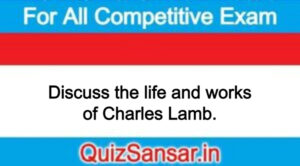
Discuss the life and works of Charles Lamb.
Discuss the life and works of Charles Lamb.
Ans.
LIFE AND WORKS
Charles Lamb was born on February 10, 1775 in London. He was a Londoner both by birth and by life-long residence. He was the seventh and the youngest child of his parents. His father, John Lamb, was a confidential clerk to the barrister Samuel Salt, a Bencher of the Inner Temple. His mother was Elizabeth Field. The first seven years of his life (1775-1782) were spent within the precincts on Crown Office Row. His early tutor was Mr. Willian Bird, an ’eminent’ writer and teacher of languages’. Then for the next seven years (1782 1789), under the influence on Samuel Salt, he went to Christ’s Hospital for further studies. Here he formed a life-long friendship with Samuel Taylor Coleridge, his three years senior. Lamb was a nervous and timid child. He had an infirmity of speech. He could not pursue his studies further.
In 1792, he was appointed as a clerk in East India House, where he remained for thirty-three years and retired in the spring of 1825 with a pension of three-quarters of his salary. In one of his jokes he said that his real works were to be found on the shelves of the East India Company.
An unhappy love affair unhinged his mind which resulted in a brief confinement in a mad house. Then something more terrible happened. His sister Mary, in a fit of lunacy stabbed their, mother to death. This event deter mined the course of Lamb’s future life. He broke off his marriage and remained a life-ling bachelor in order to be able to devote himself to the care of his invalid sister who had to live off and on in a mad house. While brother and sister moved from lodging to lodging, the constant change of place being a painful necessity, Charles started in his literary career. The Elizabethan dramatist had begun to exert their influence upon the literary world of the time. Lamb also came in touch with the leading literary luminaries like Wordsworth, Southey, Dyer and others.
In 1800, Lamb shifted to Chapel street with Mary. Coleridge introduced him to the editor of the Morning Post’, In 1801, he wrote a tragedy, John Woodville which was rejected by the manager of the Druy Zane Theatre.
The last few years of Lamb’s life were spent in peace and contentment. He was now free form financial strains. Now he had also become famous as a writer and a critic. In 1823, Lamb left London and took a cottage at Islington. Here he adopted Emma Isola, a young orphan whose presence brightened the lives of brother and sister until her marriage in 1833 to E. Maxon, the publisher. Now his health began to deteriorate. His sister Mary’s fits also be came more frequent and of longer duration. The death of Coleridge depressed him. The friendship had been very long and precious one. Owing to an accident, he fell ill with erysipelas which could not be cured. He passed away painlessly on December 27, 1834, his sister survived him nearly thirteen years.
Works: Apart from essay, Lamb tried his hand at poetry. drama and criticism as well. His works may be classified under following heads;
1. Poetic Works:
(i) Old Familiar Faces (1798)- early poems written in blank verse.
(ii) To Hester (1803)- a lyrical ballad.
(iii) Other Poems – Prince Doris, a verse story of unrequited love; On an infant Dying as soon as Born; and She is going.
2. Essays of Elia (Prose): Lamb’s essays appeared in the London Magazine under the pen name of Elia. The first volume of the Essays of Elia was published in 1823. The second volume entitled ‘The Last Essay of Elia’ was published in 1833. On account of the popularity of his essays, Lamb has been given the title of The Prince of The Essayists”.
3. Dramatic Works:
(i) John Woodville (1801) – A tragedy;
(ii) Mr. H-or Beware a Bad Name (1806) – a Play;
(iii) The Pawnbroker’s Daughter – a prose drama;
(iv) The Wife’s Trail or The Intruding Widow – a drama in blank verse.
4. Stories:
(i) Tales from Shakespeare (1807) – Written for children of which fourteen Comedies by Mary and Six tragedies by Lamb.
(ii) Adventures of Ulysses (1809) – Stories based of Chapman’s translation of Homer’s Odyssey.
(iii) Mrs. Leicester’s School or The History of Several Young ladies Related by Themselves (1809) – a collection of tertiles for children, of these seven tales were Written by Mary Lamb.
5. Novel – Rosamund Gray (1798).
6. Criticism – Specimens of English Dramatic Poets Contemporary with Shakespeare (1808).
-
Write the critical appreciation of the poem No. 12 entitled Far Below Flowed.
-
Write the critical appreciation of the poem No. 11 entitled Leave this Chanting.






